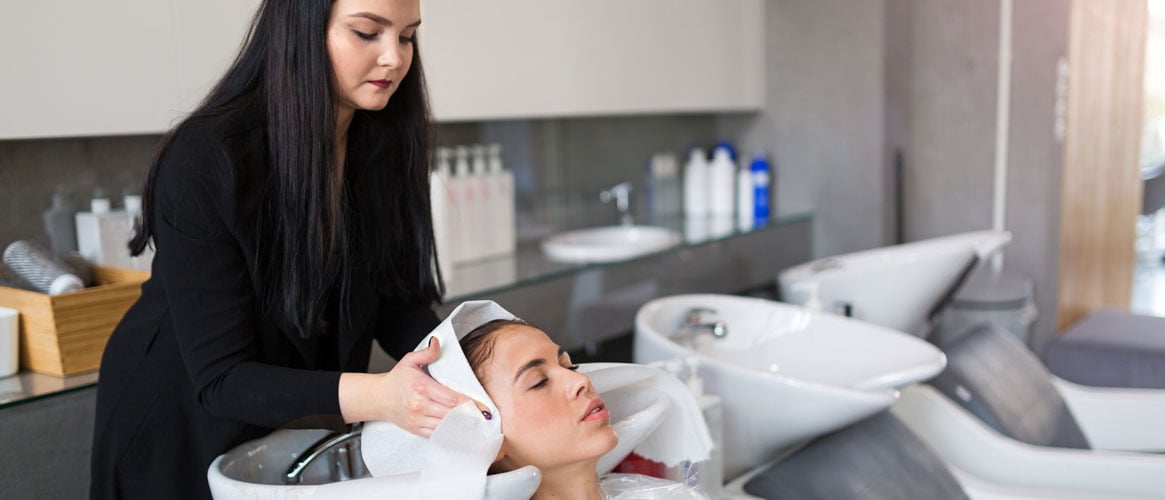Hairstylists and barbers face the risk of musculoskeletal disorders (MSDs) due to awkward postures, repetition, and static loading combined with the high customer turnover. A hand surgeon (Chiavaras and Neimken, 2000) stated that in treating hairstylists who have been practicing for 5-10 years, almost all of them came in complaining of pain or numbness in the upper extremities—the hand, wrist, and shoulder.1 As is usually the case with ergonomic risk, some of the cause can be seen as equipment-related, while a portion may be attributed to personal technique.
Typical postural issues include:
- Excessive shoulder flexion and shoulder abduction, often caused by working with the elbow at or greater than shoulder height, may cause a shoulder condition called thoracic outlet syndrome (TOS) and may be a contributing factor to hand and wrist disorders like carpal tunnel syndrome (CTS).
- Trunk flexion (bending forward at the waist) because the chair may not be at the proper height for the cosmetologist.
- Forward neck flexion, considered excessive if the angle of flexion is more than 20°.
- Wrist deviation using scissors or hand shears. Awkward wrist postures include radial deviation (to the thumb side) and ulnar deviation (to the little finger side), extension (wrist bent up), flexion (wrist bent down), pronation (palm down), and supination (palm up).
Innovations in shears design greatly lessen the risk of awkward shoulder and wrist postures. One such design, called the crane grip or crane shears, straightens the wrist, re-orients the elbow posture from near shoulder height to a more neutral position, and reduces thumb travel by 30% as the thumb and fingers are held in a more open position. This is the biggest haircutting shears design change since the early 1900’s.
Other consideration for reducing the risk of MSDs include:
- Shampoo Bowl. Shampooing may result in excessive trunk flexion for the cosmetologist. A relatively new product allows the cosmetologist to adjust the shampoo bowl to the seated height of the client to better match the standing height of the cosmetologist thus lessening the degree of trunk flexion.
- Chair adjustment. Adjust the chair so that it puts the client’s head slightly above waist height of the cosmetologist. This will help keep the hands and arms operating in a more neutral zone, while not putting the point of operation so low that bending forward (trunk flexion) or tilting the head down to see (forward neck flexion) results.
- Technique. This plays a bigger role in this occupation than in most. The standard cutting technique is to grasp the hair between the fingers of the non-dominant hand. This results in shoulder abduction and extreme wrist deviation. An option is to use a comb to grasp, measure, and hold the hair. The key factor to consider when using the comb is that it should be positioned from below—from a neutral zone for the hands and arms—rather than from over the top, as often occurs with the standard technique.
- Sharpen the shears. It is important to regularly sharpen the shears. This will decrease the friction and reduce the force of cutting. It will also give the client a cleaner, smoother haircut.
- Static Loading. Static loading is holding a posture (neutral or non-neutral) for long periods of time with little or no gross movement. As scheduling permits, alternate chair work with other tasks such as sweeping, stocking, folding towels, and setting up for the next few clients—something that encourages gross movement. Standing for long periods on hard surfaces is a form of static loading. Anti-fatigue matting is often a remedy. If matting is not feasible, consider shoe insoles to reduce fatigue transmitted from standing and walking on hard floor surfaces.
1 Boyles, J., Yearout, R., Malgorzata, J., Ergonomic scissors for hairdressing, International Journal of Industrial Ergonomics 32, 2003, pp 199-207.
